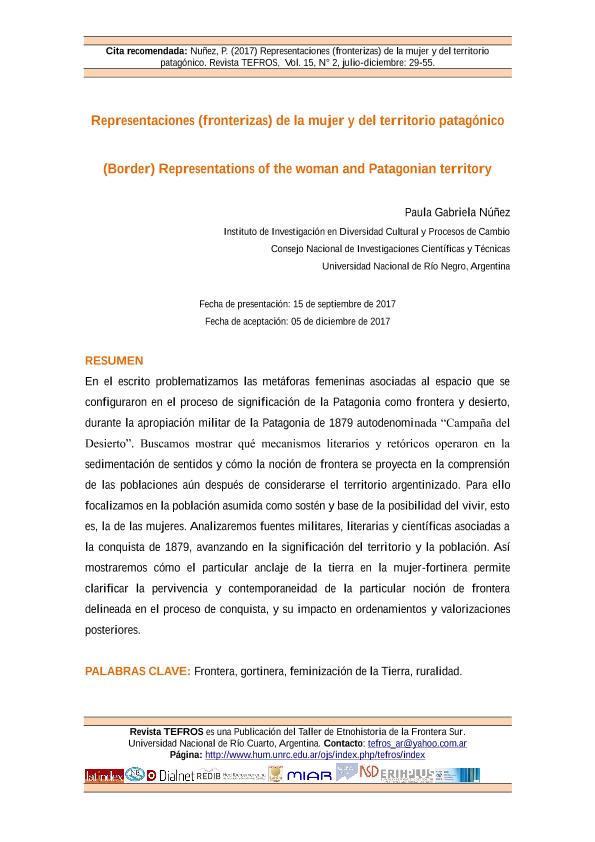Mostrar el registro sencillo del ítem
dc.contributor.author
Nuñez, Paula Gabriela

dc.date.available
2018-09-06T14:54:20Z
dc.date.issued
2017-12
dc.identifier.citation
Nuñez, Paula Gabriela; Representaciones (fronterizas) de la mujer y del territorio patagónico; Universidad Nacional de Río Cuarto. Facultad de Humanidades; Tefros; 15; 2; 12-2017; 29-55
dc.identifier.issn
1669-726X
dc.identifier.uri
http://hdl.handle.net/11336/58502
dc.description.abstract
En el escrito problematizamos las metáforas femeninas asociadas al espacio que se configuraron en el proceso de significación de la Patagonia como frontera y desierto, durante la apropiación militar de la Patagonia de 1879 autodenominada “Campaña del Desierto”. Buscamos mostrar qué mecanismos literarios y retóricos operaron en la sedimentación de sentidos y cómo la noción de frontera se proyecta en la comprensión de las poblaciones aún después de considerarse el territorio argentinizado. Para ello focalizamos en la población asumida como sostén y base de la posibilidad del vivir, esto es, la de las mujeres. Analizaremos fuentes militares, literarias y científicas asociadas a la conquista de 1879, avanzando en la significación del territorio y la población. Así mostraremos cómo el particular anclaje de la tierra en la mujer-fortinera permite clarificar la pervivencia y contemporaneidad de la particular noción de frontera delineada en el proceso de conquista, y su impacto en ordenamientos y valorizaciones posteriores.
dc.description.abstract
In this manuscript we explore space-gender metaphors which were configured in the process of signification of Patagonia as border and desert during the 1879 military appropriation of Patagonia or "Desert Campaign." We seek to evidence what literary and rhetorical mechanisms operated in the sedimentation of territorial senses and how the notion of border is projected in the understanding of the populations, even after considering the place Argentine. For that purpose, we focus on the social sector that became the support and the basis of life possibility for the female population. We will analyze military, literary, and scientific sources associated with the 1879 military campaign, by studying the significance of the territory and the population. We will also show how the particular anchoring of the land in the fortress-women enables us to clarify the survival and the contemporaneity of the notion of border delineated in the process of conquest, and its impact on subsequent legislation and appraisals.
dc.format
application/pdf
dc.language.iso
spa
dc.publisher
Universidad Nacional de Río Cuarto. Facultad de Humanidades

dc.rights
info:eu-repo/semantics/openAccess
dc.rights.uri
https://creativecommons.org/licenses/by-nc-sa/2.5/ar/
dc.subject
Frontera
dc.subject
Fortinera
dc.subject
Feminización de La Tierra
dc.subject
Ruralidad
dc.subject.classification
Otras Ciencias Sociales

dc.subject.classification
Otras Ciencias Sociales

dc.subject.classification
CIENCIAS SOCIALES

dc.title
Representaciones (fronterizas) de la mujer y del territorio patagónico
dc.title
(Border) Representations of the woman and Patagonian territory
dc.type
info:eu-repo/semantics/article
dc.type
info:ar-repo/semantics/artículo
dc.type
info:eu-repo/semantics/publishedVersion
dc.date.updated
2018-09-04T18:36:34Z
dc.journal.volume
15
dc.journal.number
2
dc.journal.pagination
29-55
dc.journal.pais
Argentina

dc.journal.ciudad
Río Cuarto
dc.description.fil
Fil: Nuñez, Paula Gabriela. Consejo Nacional de Investigaciones Científicas y Técnicas. Centro Científico Tecnológico Conicet - Patagonia Norte. Instituto de Investigaciones en Diversidad Cultural y Procesos de Cambio. Universidad Nacional de Río Negro. Instituto de Investigaciones en Diversidad Cultural y Procesos de Cambio; Argentina
dc.journal.title
Tefros

dc.relation.alternativeid
info:eu-repo/semantics/altIdentifier/url/http://www.hum.unrc.edu.ar/ojs/index.php/tefros/article/view/517
Archivos asociados
